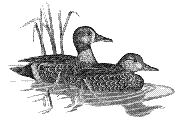US Fish & Wildlife Service
Date of this Version
January 1990
Abstract
Waterfowl managers and researchers must often capture ducks to band, mark, or measure. During fall and winter, cannon nets, walk-in bait traps, or swim-in traps with funnel entrances are commonly used to capture ducks. However, all of these use bait, usually grain, to lure birds. During the breeding and post-breeding periods, when the diet of many dabbling duck species is dominated by aquatic invertebrates, birds often respond poorly to bait traps. Many diving ducks do not respond to bait traps at any time of the year. Decoy traps are an effective alternative to bait traps in spring and early summer because they rely on behavioral responses, not food, to attract and capture birds.
Portable decoy traps employ one or more live "decoy" ducks confined at a highly visible, over water site. Wild ducks are captured when they attempt to approach these decoy birds. This behavioral reaction seems to be based largely on either a territorial response (territorial individuals approach a conspecific with the intent of ejecting it from a territory) or a mate-seeking response (birds approach a prospective mate). However, since species different from that of a decoy bird are also captured, ducks probably also approach while seeking a place to loaf, preen, or feed.


Comments
Published in Diana H. Cross and Paul Vohs (eds.) Waterfowl Management Handbook. Fort Collins, CO: U.S. Fish and Wildlife Service, 1988. Online at http://www.nwrc.usgs.gov/wdb/pub/wmh/contents.html